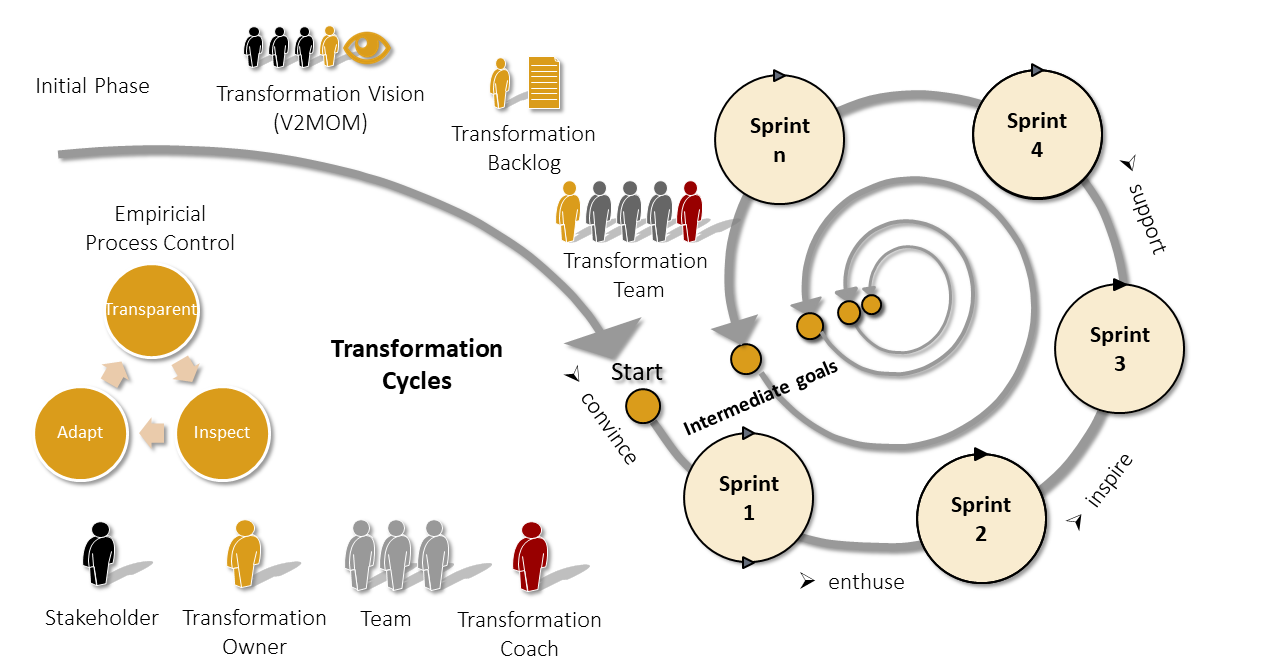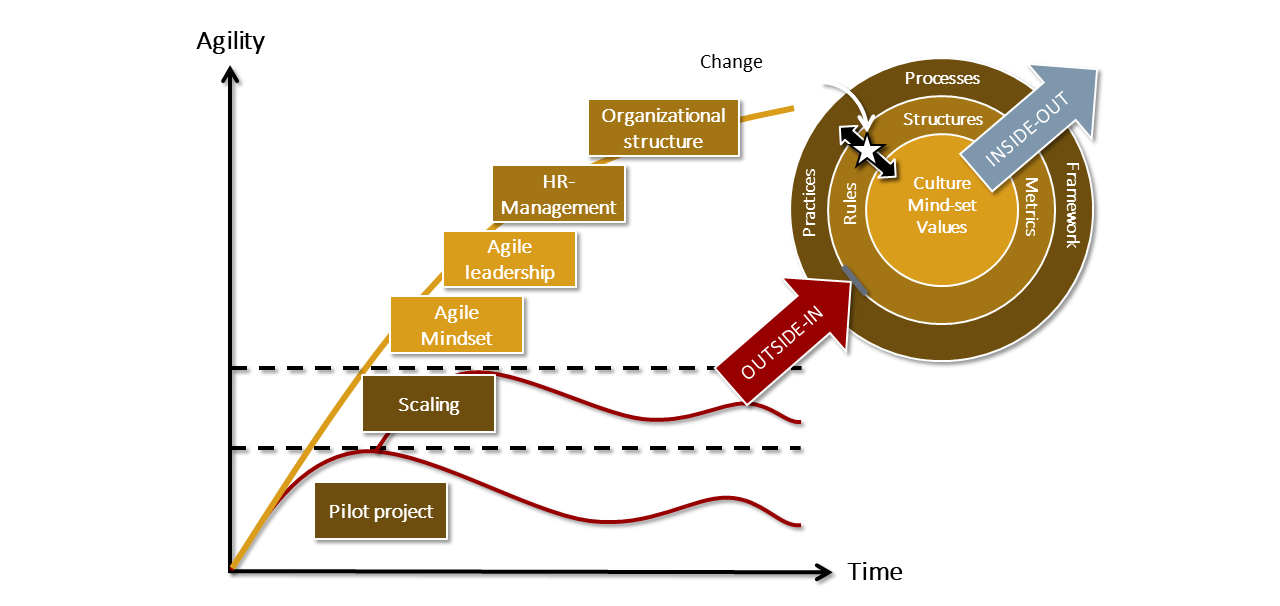Deploying an agile Transformation Team
Those who deal with the topic of agility in more detail in preparation for the deployment of agile teams in the company have created an agile awareness. This means they have understood that it is about more than just a project team using a different method to develop a product. In addition to the agile teams, the change process also affects the environment of these teams and the managers, as well as the value system and the corporate culture. In order to moderate this complex process in a structured way right from the start and to support it to the best of our ability, a transformation team is set up.

The agile transformation team
Complex processes are particularly suited to working successfully with agility. Therefore, the transformation team works with maximum agility. First, all roles need to be filled. The transformation team needs a Product Owner. Ideally, this role is filled by a member of top management. This person is responsible for the backlog and may also have to allocate budgets, e.g. for culture change programmes. In addition, the role of Scrum Master must be filled. A person who already has practical experience with the method is a good choice. In addition, he should have a certain “standing”, in order to be able to talk about behavioural changes at eye level with managers at all levels. Acceptance is an important factor here. Last but not least, a “working team” is needed. It makes sense to staff this team with people from different areas and hierarchical levels who are well-networked with colleagues. Ultimately, all employees of the company should be involved in the agile transformation. However, not all employees can participate in the transformation team. The rule here, as with other agile teams, is that there should be a maximum of 11 people – including the Product Owner and Scrum Master – in order to work as efficiently as possible.
Here you can find more information on Scrum.
In tandem with the product vision, the transformation team needs a transformation vision. This contains the mission statement on which the transformation process is to be based. Based on this vision, the Product Owner develops the initial backlog. In view of the fact that many points in the transformation are open-ended at the beginning, i.e. no one can say exactly at the starting point in which form and in which way they will be implemented, the initial backlog consists largely of items that deal with clarifications. Of course, there can also be very concrete items, such as the equipment found in the agile rooms.
The transformation team works in scrum mode
The transformation team starts work on the basis of the initial backlog. It works in sprints and carries out all events that are required in a Scrum mode. A challenge for sprint planning is that the members of the Scrum team usually do not work full time on the transformation. Therefore, they plan their tasks for the upcoming sprint based on the amount of time they can allocate to the task. In the daily, members report on the progress they have made and what they have to do next, or what impediments (obstacles) they have encountered. The review is of particular importance because a transformation team has a broad base of stakeholders. On the one hand, these are the employees who will later work in an agile way or who have already been doing so for some time. For them, it is important to create the best framework conditions for agile working in their projects. In addition, those managers are affected, whose role is changing significantly and who have to change their management style. Executive management is also particularly important here. They must support or even exemplify the new cultural values. This also applies to non-agile areas. The core of creating agility is usually within development. Other areas can only partially or conditionally adapt methods such as Scrum or Kanban. Nevertheless, they must be included in the new value and management system.
This change process is a big challenge for every company. When an agile pilot is installed, it is often underestimated as to which issues will be raised sooner or later by the teams, perhaps even demanded, because they are not able to solve them within the framework of their team. A transformation team deployed early on addresses these issues and ensures that agility does not become an agile show, but a real benefit for the company.
In this process, the support of experienced agile coaches is enormously helpful. Many of the items that appear in the transformation team’s backlog are completely new to the team members. Of course, after a few iterations of learning, you can usually find reasonable solutions to these issues. But often, with the right approach, you can arrive efficiently at a better solution if you allow for an outside view and can incorporate the experience of other companies. This also applies to the next step: Extend agility.
The consultants at CO Improve can also bring years of experience from numerous agile transformations into your change process. It pays to take the right steps when entering new territory, especially at the beginning.
The benefit to you
- You benefit more quickly from the advantages of real agile working.
- You develop your individual, company-specific agile framework including governance model.
- All areas and hierarchical levels are systematically included in the agile transformation, right from the start.
- The value system introduced with agility meets with a high level of acceptance because all stakeholders were involved in the design.
- The interfaces from (and to) the agile teams are clearly defined and even areas that will not work agilely in the long-term know their role in dealing with agile teams.


